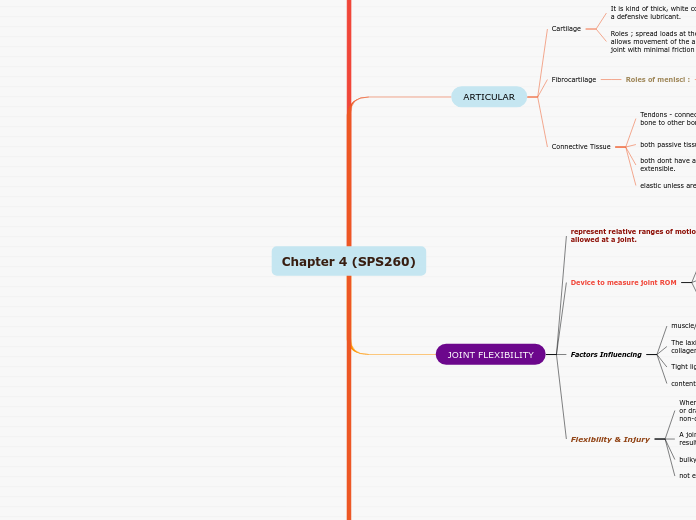Chapter 4 (SPS260)
Classification of Joints
Synarthroses
force that absorb shock but permit little or no movement of the articulating bone.
Sutures
articulating bone sheets with irregular grooves mate together and firmly bound by fibres
ex ; sutures of the skull
Syndesmoses
the bones r held together by thick fibrous tissue, which allow for every little mobility.
ex ; mid - tibiofibular , inferior tibiofibular joints.
Amphiarthroses
Synchondroses
applied force & allow more motion of the adjoining bones than the synarthrodial joint (- held together by a thin layer of hyaline cartilage.
ex ; strenocostal joint
Symphyses
thin plates of hyaline cartilage seperate a disc of fibrocartilage from the bones
ex ; vertebral joints, pubic
Diarthroses
- articular cartilage a protective layer of dense white connective tissue covering articulating surfaces
Gliding (plane, arthrodial) - almost flat & the only movement permitted is non - axial guiding.
eg ; intermetatarsal, intercarpal & intertarsal joints
Hinge (ginglymus) - solid collateral ligaments limit mobility to a planar, hinge-like movement
eg ; ulnohumeral & interphalangeal joints)
Pivot (screw, trachold) - rotation permitted around one axis .
eg ; atlantoaxial joint
Condyloid ( avoid; ellipsoidal)
- The top of the articulating bone has an ovular convex appearance.
eg ; 5th metacarpophalangeal joints
Saddle (sellar) - articulating bone surfaces are both shaped like the seat of riding saddle in these joints
ex ; carpometacarpal joint of the thumb
Ball & Socket (spheroidal ) - the surfaces of the articulating bones are reciprocall convex & concave.
ex ; hips & shoulder joints.
ARTICULAR
Cartilage
It is kind of thick, white connective tissue that act as a defensive lubricant.
Roles ; spread loads at the joint over a wide area. allows movement of the articulating bones at the joint with minimal friction and wear.
Fibrocartilage
Roles of menisci :
distribute of loads over the joint surfaces.
- improvement of the fit of the articulating surfaces.
- limitation of translation or slip of one bone w respect to another.
Connective Tissue
Tendons - connect muscle to bones and ligaments which connects bone to other bones
Obstacles
Obstacles
both passive tissues
both dont have ability to contract but slightly extensible.
elastic unless are stretch beyond their limits
JOINT FLEXIBILITY
represent relative ranges of motion (ROM) allowed at a joint.
Device to measure joint ROM
Goniometer ( a proctractor w two arms.)
Electrogoniometer ( use for monitoring changes in joint angle during the use from different activities)
Leighton Flexomete (to measure change in the orientation of a body segment)
Factors Influencing
muscle/fatty tissue may finalise the movement.
The laxity (looseness) & extensibility of the collagenous tissues & muscles that cross the joint.
Tight ligaments & muscle will restrict ROM
content synovial fluid
Flexibility & Injury
When joint flexibility very low, extremely moderate, or dramatically imbalanced between the dominant & non-dominant sides of the body, risk of injury is high
A joint that is very loose & lax is unstable and, as a result vulnerable to displacement-related injuries.
bulky muscles may inhibit joint ROM
not enough physical activity lessen the flexibility.
COMMON JOINT INJURIES & PATHOLOGIES
SPRAIN
CAUSED by irregular displacement or bending of the articulating bones, resulting in stretching or breaking of ligaments, tendons, and connective tissues that cross the joint. Joint sprains cause pain and swelling
Symptoms ; pain & swelling
DISLOCATION
at a joint, the articulating bones shift. Often occur as a result of falls or other mishaps requiring a significant magnitude of force. Dislocations often occur at the following locations; shoulders,toes, feet, elbows, and jaw are all affected
Symptoms: visible deformity, pain swelling and usually some loss of joint movement capability
BURSITIS
happen when overuse injury caused by excessive use of a joint produces irritation and inflammation of one or more bursae.
symptons ; pain & possibly some swelling
Arthritis
Pathology involving joint inflammation accompanied by pain & swelling
extremely common w aging
Rheumatoid Athritis
a lot painful form of arthritis because autoimmune disorder that involves the body's immune system attacking healthy tissues. (common in adults)
Characteristic
Inflammation & thickening the synovial membranes & breakdown of the articular cartilage.
Symptoms
Anemia, fatigue, muscular atrophy, osteoporosis & other systemic changes
Osteoarthritis
common of non-inflammatory degenerative arthritis. Early stage of the disorder. Joint cartilage loses the smooth glistening appearance & become rough and irregular
Symptoms ; pain, swelling, RROM restriction & stiffness, unknown causes.
